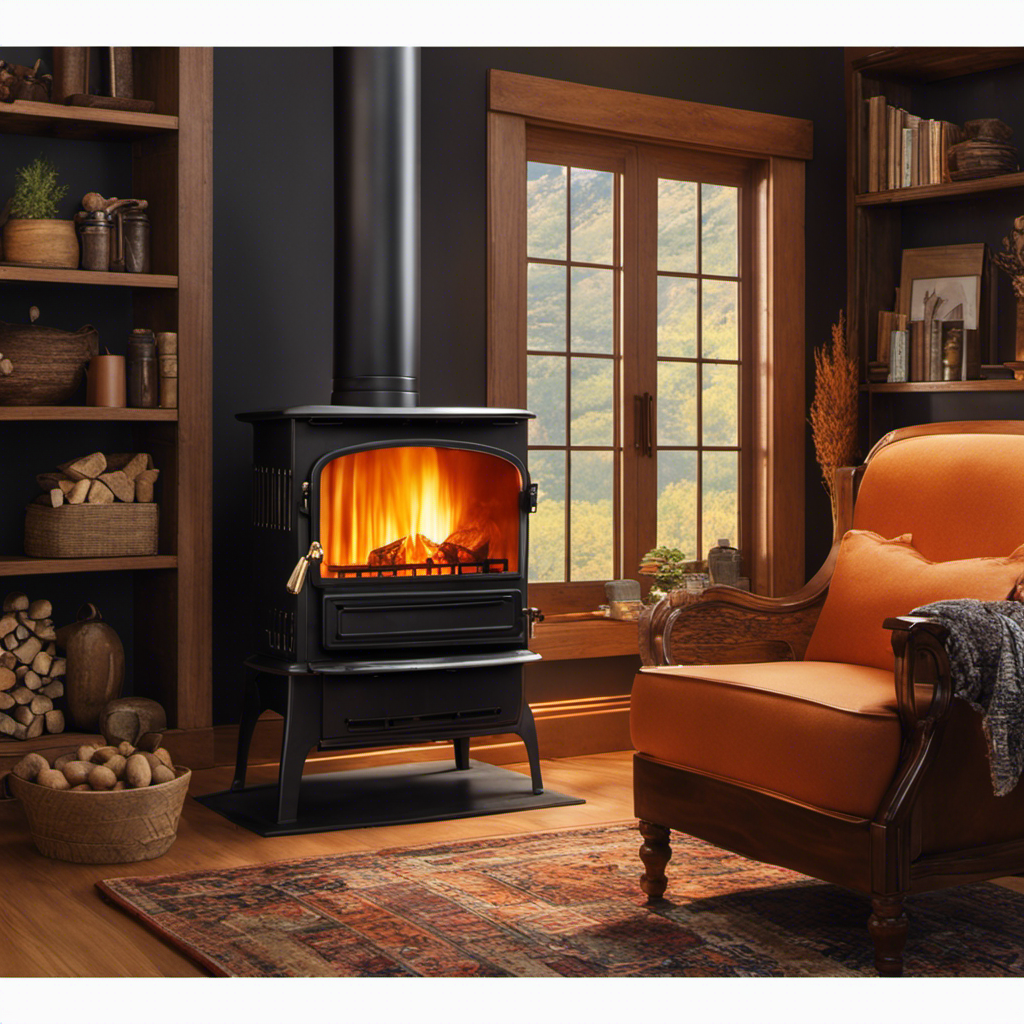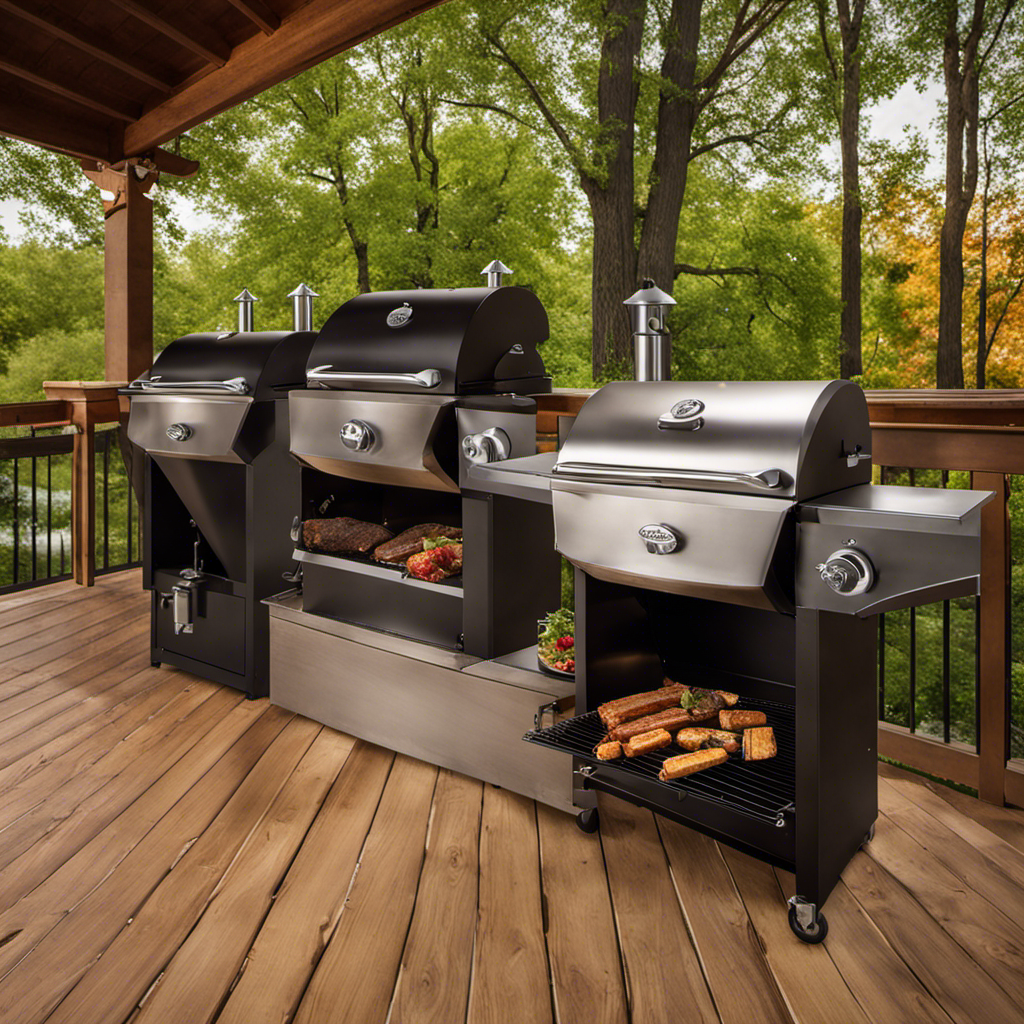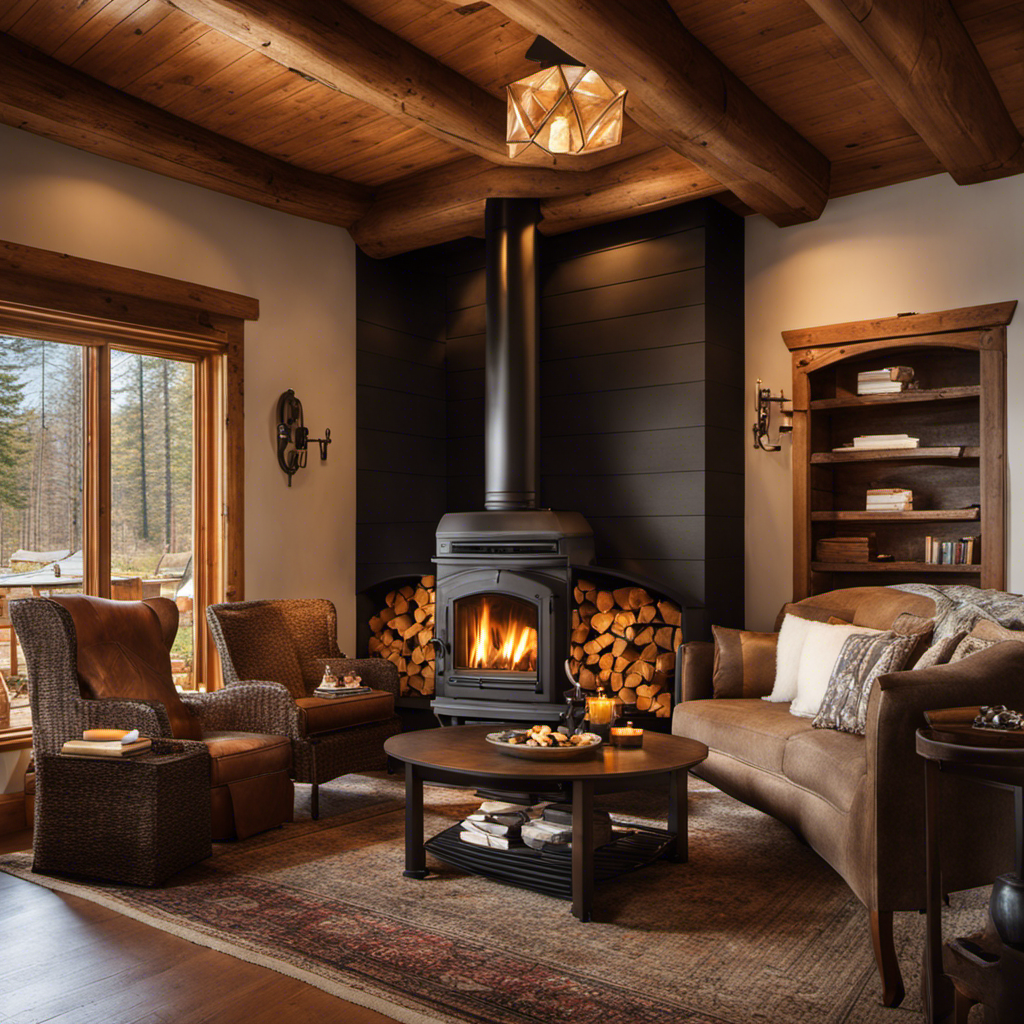Having a considerable amount of experience with wood-burning stoves, I recognize that achieving the optimal temperature is essential for their effective and safe use. So, what would be the perfect operating temperature for a wood stove?
Let me guide you through the optimal temperature range, the factors that influence heat levels, and the benefits of maintaining the right temperature.
With my expert tips and safety precautions, you’ll have complete control over your wood stove’s temperature, ensuring a cozy and enjoyable experience.
Get ready to master the art of wood stove heat!
Key Takeaways
- The recommended temperature range for a wood stove is 400°F to 600°F to ensure efficient combustion and reduce creosote buildup.
- Temperatures below 400°F result in incomplete combustion and lower efficiency, while temperatures above 600°F can damage the stove and surrounding materials.
- Factors such as the type of wood, properly seasoned wood, moisture content, firebox size, and air intake settings can affect wood stove heat levels.
- Maintaining the right heat level in a wood stove has benefits such as optimal fuel efficiency, consistent and even heat distribution, reduced risk of creosote buildup, extended lifespan of the stove, and enhanced safety.
Understanding the Optimal Temperature Range
I find it important to understand the optimal temperature range for a wood stove. Wood stove efficiency is greatly influenced by the temperatures it operates at. Maintaining the recommended wood stove temperatures ensures efficient combustion and reduces the risk of creosote buildup.
The optimal temperature range for a wood stove typically falls between 400°F and 600°F. This range allows for complete combustion of the wood, ensuring maximum heat output and minimal emissions. Temperatures below 400°F can lead to incomplete combustion, resulting in lower efficiency and increased pollution.
On the other hand, temperatures above 600°F can cause excessive heat, potentially damaging the stove and surrounding materials. By maintaining the recommended wood stove temperatures, you can maximize the efficiency of your wood stove while also ensuring its safe operation.
Factors Affecting Wood Stove Heat Levels
Based on my research, certain factors such as the type of wood used, the size of the firebox, and the air intake settings can all impact the heat levels produced by a wood stove.
To further understand the wood stove fuel efficiency and the impact of stove design on heat levels, consider the following:
-
Type of wood:
-
Hardwoods burn longer and produce more heat than softwoods.
-
Properly seasoned wood burns more efficiently and generates higher heat levels.
-
Moisture content affects burn efficiency and heat output.
-
Firebox size:
-
A larger firebox allows for more wood to be burned, resulting in increased heat output.
-
A smaller firebox requires more frequent refueling, potentially decreasing overall heat levels.
-
Air intake settings:
-
Adjusting the air intake controls the combustion process, influencing heat levels.
-
A higher air intake setting can increase the rate of burn and produce more heat.
Considering these factors and optimizing them can significantly impact the heat levels produced by a wood stove, enhancing its efficiency and effectiveness.
Benefits of Maintaining the Right Heat Level
Maintaining the right heat level in my wood stove ensures optimal fuel efficiency and maximizes the warmth in my home. Temperature regulation is of utmost importance when it comes to wood stoves, as incorrect heat levels can have a significant impact on both the stove’s performance and the overall comfort of the living space.
To help you understand the importance of temperature regulation, I have created a table outlining the benefits of maintaining the right heat level in a wood stove:
| Benefits of Maintaining the Right Heat Level |
|---|
| 1. Optimal fuel efficiency |
| 2. Consistent and even heat distribution |
| 3. Reduced risk of creosote buildup |
| 4. Extended lifespan of the stove |
| 5. Enhanced safety |
By keeping the temperature within the recommended range, I ensure that the wood burns efficiently, minimizing wasted fuel and reducing the frequency of refueling. Additionally, maintaining the right heat level ensures a consistent and even heat distribution throughout my home, eliminating hot and cold spots.
Incorrect heat levels can lead to the formation of creosote, a flammable substance that accumulates in the chimney. This buildup can pose a serious fire hazard, making it crucial to regulate the temperature properly.
Furthermore, maintaining the right heat level promotes the longevity of my wood stove. Excessive heat can cause damage to the stove’s components, leading to costly repairs or even the need for replacement.
Last but not least, maintaining the right heat level ensures the safety of my home and family. By preventing overheating, I reduce the risk of accidents and potential fire hazards.
Tips for Controlling Wood Stove Temperature
Controlling the temperature of my wood stove is essential for maintaining a comfortable and safe environment in my home. To ensure efficient temperature control, here are a few tips I’ve learned:
-
Keep the air vents clear: Proper air ventilation is crucial for regulating the temperature. Make sure the air vents aren’t blocked by furniture or other objects.
-
Use the damper: Adjusting the damper allows for better control of the airflow. Opening it increases heat output, while closing it reduces it.
-
Burn dry and seasoned wood: Wet or unseasoned wood can lead to lower temperatures and less efficient burning. Ensure the wood is properly seasoned before using it in the stove.
Troubleshooting common temperature issues:
-
Inspect the gasket: A worn-out or damaged gasket can cause heat loss. Replace it if necessary.
-
Check for leaks: Leaks in the stovepipe or chimney can lead to insufficient heat. Seal any gaps or cracks to improve efficiency.
-
Clean the stove: A buildup of soot and debris can hinder proper airflow and result in lower temperatures. Regularly clean the stove to maintain optimal performance.
Safety Precautions When Operating a Wood Stove
To ensure a safe operation of my wood stove, I always make sure to regularly check and clean the chimney for any potential blockages. This is a crucial step in maintaining proper ventilation and preventing any potential hazards.
One of the most common mistakes people make when operating a wood stove is neglecting the importance of ventilation. Without proper airflow, the combustion process can be incomplete, leading to the buildup of dangerous gases like carbon monoxide. These gases can be deadly if not properly vented out of the house.
Regularly inspecting and cleaning the chimney ensures that the smoke and gases are safely expelled from the stove and directed outside. Additionally, a blocked chimney can also cause a backup of smoke and soot, which can damage the stove and potentially cause a fire.
Therefore, it’s vital to prioritize proper ventilation and regularly maintain the chimney to ensure the safe operation of your wood stove.
Frequently Asked Questions
How Often Should I Clean My Wood Stove to Maintain the Optimal Temperature Range?
When it comes to maintaining the optimal temperature range for my wood stove, I find that cleaning it regularly is crucial. By cleaning it frequently, I ensure that it operates efficiently and can reach the desired heat levels.
Can I Use Softwoods Like Pine in My Wood Stove, or Is It Better to Stick to Hardwoods?
Using softwoods like pine in a wood stove is acceptable, but hardwoods offer better benefits. Softwoods burn hotter, but hardwoods provide longer-lasting and more consistent heat. Stick to hardwoods for optimal performance.
What Are the Signs That My Wood Stove Is Not Reaching the Right Heat Level?
If your wood stove is not reaching the right heat level, there are several signs to watch for. Look for weak flames, excessive smoke, or difficulty in keeping the fire going. To maximize efficiency, ensure proper airflow and use dry hardwoods.
Are There Any Alternative Methods for Controlling Wood Stove Temperature, Other Than Adjusting the Air Vents?
When it comes to controlling wood stove temperature, there are alternative methods besides adjusting air vents. One option is using a damper, which regulates airflow. Another method is using a heat exchanger, which transfers heat to other areas.
Are There Any Specific Safety Measures I Should Take When Leaving the House With My Wood Stove Still Burning?
When leaving a wood stove burning, it is essential to follow safety precautions. Ensure all flammable materials are clear, close the damper to reduce oxygen supply, and properly extinguish the fire by removing burning logs and ashes.
Conclusion
In conclusion, maintaining the optimal temperature range for a wood stove is crucial for efficient and safe operation. By understanding the factors that affect heat levels and following the tips for temperature control, you can enjoy the benefits of a well-functioning wood stove.
Symbolically, keeping the fire in the desired temperature range represents the harmony between nature and technology, creating a cozy and comforting atmosphere in your home.
Stay warm and be mindful of safety precautions when using your wood stove.











